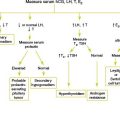Chapter 1 ABDOMINAL PAIN (CHRONIC AND RECURRENT)
General Discussion
1. Persistent or recurrent pain or discomfort centered in the upper abdomen (superior to the umbilicus)
2. Not relieved by defecation or associated with the onset of a change in stool frequency or stool form (i.e., not IBS)
3. No evidence of an inflammatory, anatomic, metabolic, or neoplastic process that explains the subject’s symptoms
1. Abdominal discomfort (an uncomfortable sensation not described as pain) or pain associated with two or more of the following at least 25% of the time:
2. No evidence of an inflammatory, anatomic, metabolic, or neoplastic process that explains the subject’s symptoms
1. Episodic or continuous abdominal pain
2. Insufficient criteria for other functional gastrointestinal disorders
3. No evidence of an inflammatory, anatomic, metabolic, or neoplastic process that explains the subject’s symptoms
1. Some loss of daily functioning
2. Additional somatic symptoms such as headache, limb pain, or difficulty sleeping
1. Paroxysmal episodes of intense, acute periumbilical pain that lasts for 1 hour or longer
2. Intervening periods of usual health lasting weeks to months
3. The pain interferes with normal activities
4. The pain is associated with two or more of the following:
5. No evidence of an inflammatory, anatomic, metabolic, or neoplastic process that explains the subject’s symptoms
Causes of Chronic or Recurrent Abdominal Pain
Key Historical Features
Key Physical Findings
 Weight-for-height documentation
Weight-for-height documentation
 Abdominal examination for general appearance, location of tenderness, mass, rebound, distention, psoas sign, liver size, spleen size, kidney size, or ascites. Auscultation for bowel sounds and bruits
Abdominal examination for general appearance, location of tenderness, mass, rebound, distention, psoas sign, liver size, spleen size, kidney size, or ascites. Auscultation for bowel sounds and bruits
 Back examination for flank tenderness
Back examination for flank tenderness
Suggested Work-Up
| Symptom diary | A diary that includes diet, symptoms, and associated features may help to identify potential causes of the patient’s symptoms |
| Complete blood count (CBC) with differential | To evaluate for infection, inflammation, or anemia |
| Erythrocyte sedimentation | To evaluate for inflammatory processes |
| Urinalysis and urine culture | To evaluate for urinary tract infection or hematuria |
| Stool testing for occult blood | To evaluate for gastrointestinal bleeding |
| Pregnancy test | For girls of reproductive age |
Additional Work-Up
| Serum electrolytes, creatinine, blood urea nitrogen (BUN), and glucose | To evaluate for a metabolic cause for abdominal pain |
| Liver enzymes and amylase | To evaluate for liver disease or pancreatitis |
| Stool culture | If a bacterial infection is suspected |
| Stool testing for ova and parasites or Giardia antigen | If a parasitic or protozoal cause is suspected |
| Serologic testing for Helicobacter pylori | If H. pylori infection is suspected |
| Cultures for sexually transmitted diseases | If risk factors are present in the history or if the physical examination suggests sexually transmitted disease |
| Carbohydrate breath testing | To evaluate for lactose intolerance |
| Abdominal and pelvic ultrasonography |
Ultrasound typically is one of the first imaging studies used because of its sensitivity for free fluid and the frequency of retroperitoneal disease. Ultrasound is able to inspect the ileum for Crohn’s disease as well as adenopathy and chronic features of abscess from fistulas or Meckel’s diverticulum. |
1. Subcommittee on Chronic Abdominal Pain. Technical report. Chronic abdominal pain in children. Pediatrics. 2005;115(3):e370–381.
2. Lake A.M. Chronic abdominal pain in childhood: diagnosis and management. Am Fam Physician. 1999;59:1823–1830.
3. Longstreth GF, Thompson WG, Chey WD, Houghton LA, Mearin F, Spiller RC. Functional bowel disorders. Gastroenterology. 2006;130:1480.
4. McCollough M, Sharieff GQ. Abdominal pain in children. Pediatr Clin North Am. 2006;53:107–137.
5. Ramchandani P.G., Hotofp M., Sandhu B., Stein A. The epidemiology of recurrent abdominal pain from 2 to 6 years of age: results of a large, population-based study. Pediatrics. 2005;116:46–50.
6. Rasquin A. Childhood functional gastrointestinal disorders: child/adolescent. Gastroenterology. 2006;130:1527–1537.
7. Zeiter D.K., Hyams J.S. Recurrent abdominal pain in children. Pediatr Clin North Am. 2002;49:53–71.



































